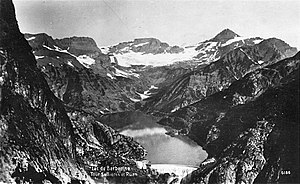Lac de Barberine
| Lac de Barberine | |||||||
|---|---|---|---|---|---|---|---|
| Barberine reservoir with Tour Sallière and Mont Ruan in the background | |||||||
|
|||||||
|
|
|||||||
| Coordinates | 559604 / 103289 | ||||||
| Data on the structure | |||||||
| Lock type: | Gravity dam | ||||||
| Construction time: | 1921-1925 | ||||||
| Height of the barrier structure : | 79 m | ||||||
| Building volume: | 206 000 m³ | ||||||
| Crown length: | 284 m | ||||||
| Crown width: | 4.5 m | ||||||
| Base width: | 58.5 m | ||||||
| Power plant output: | 47 MW | ||||||
| Operator: | SBB | ||||||
| Data on the reservoir | |||||||
| Altitude (at congestion destination ) | 1888 m above sea level M. | ||||||
| Storage space | 38 000 000 m³ | ||||||
| Total storage space : | 40 000 000 m³ | ||||||
| Design flood : | 50 m³ / s | ||||||
| Particularities: |
|
||||||
The Lac de Barberine was a reservoir built by the Swiss Federal Railways in the west of the canton of Valais in Switzerland . The lake in the municipality of Salvan sank in the larger Lac d'Emosson, which was dammed higher .
location
Framed by the mountain peaks Pic de Tenneverge , Mont Ruan and Tour Sallière , the lake was at 1886 m above sea level. M. dammed by a gravity dam.
history

In 1916, the Swiss Federal Railways (SBB) decided to electrify the railway network and thus become independent of coal imports. The electricity required for rail operations should be generated in the company's own power stations. For this purpose, the SBB acquired the rights to use the water of the Barberine in the Vallon de Barberine in the area of the municipality of Salvan in 1917 . In 1919 a loan of 35 million francs was approved for the construction of the Châtelard-Barberine power station and the associated Lac de Barberine. The plant was the upper tier of the two-stage power plant group Kraftwerk Barberine-Vernayaz , which was supposed to supply the western part of Switzerland and the Upper Valais with traction current .
The meter-gauge Chemin de fer Martigny – Châtelard (MC) was used to transport materials to the construction site of the dam, which enabled it to set a record in freight traffic in 1923. From Le Châtelard, where the power plant center was built, up to the moated castle, the SBB built a funicular in 1920 , at that time the steepest funicular with two cars.
The dam was built from 1921 to 1925. For the first time, cast concrete was used to build a dam in Switzerland . At almost the same time, the Schräh dam for the Wägitalersee and the dam for the compensation basin in Rämpensee were built using the same method. All three dams showed frost damage after only a few years of operation, which required extensive repair work and which brought the poured concrete process into disrepute. In order to better protect the barberine dam against frost, it was completely clad with granite blocks.
The lake was dammed for the first time in 1925, but the power plant had been in operation with reduced capacity since 1923.
Additional energy requirements of the railways after the Second World War required the expansion of the power station. In 1950 the upper reaches of the Triège was taken and led into the Lac de Barberine with a 3.8 km long tunnel.
In 1954, Electricité d'Emosson SA (ESA) was founded with the aim of building the much larger Lac d'Emosson . The new reservoir uses the same valley as the Lac de Barberine with a higher dam wall further up the valley so that the existing Barberine dam was flooded and could no longer be used by SBB. As compensation, she received water rights to the new reservoir from ESA.
The Lac d'Emosson was dammed for the first time in 1974. The old gravity dam rises above the water level of Lac d'Emosson when the water is low in spring, but is 42 m under water when the reservoir is full.
technology
The gravity dam is 79 m high and has a crown length of 284 m. It stands on a base of crystalline rock and dammed a lake of 39 million m³. The wall is 58.5 meters wide at the base and 4.5 meters at the top. The crown runs in a slight arc. The wall is made of cast concrete and covered with granite.
Web links
Individual evidence
- ^ Philippe Rochat: The Châtelard II-Barberine pumped storage facility of the Swiss Federal Railways: Aspects of the modernization and expansion of the power plant . In: Swiss engineer and architect . tape 97 , no. 39 , 1979, pp. 755 , doi : 10.5169 / seals-85541 ( e-periodica.ch ).
- ^ Electrification of the Gotthard Railway . In: The Bern Week . tape 9 , no. 18 , 1919, pp. 214 , col. 1 .
- ^ Marco Peter, Jean-Marie Roullier: Barrage Barberine. (PDF) swissdams (French).
- ↑ Switzerland (ed.): More electricity for the SBB . No. 10 , 1950, p. 4–5 , doi : 10.5169 / seals-774395 .


